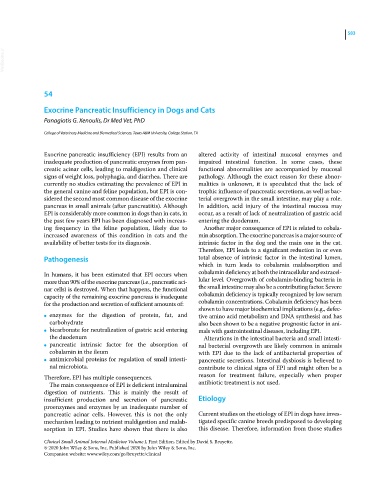Page 615 - Clinical Small Animal Internal Medicine
P. 615
583
VetBooks.ir
54
Exocrine Pancreatic Insufficiency in Dogs and Cats
Panagiotis G. Xenoulis, Dr Med Vet, PhD
College of Veterinary Medicine and Biomedical Sciences, Texas A&M University, College Station, TX
Exocrine pancreatic insufficiency (EPI) results from an altered activity of intestinal mucosal enzymes and
inadequate production of pancreatic enzymes from pan- impaired intestinal function. In some cases, these
creatic acinar cells, leading to maldigestion and clinical functional abnormalities are accompanied by mucosal
signs of weight loss, polyphagia, and diarrhea. There are pathology. Although the exact reason for these abnor-
currently no studies estimating the prevalence of EPI in malities is unknown, it is speculated that the lack of
the general canine and feline population, but EPI is con- trophic influence of pancreatic secretions, as well as bac-
sidered the second most common disease of the exocrine terial overgrowth in the small intestine, may play a role.
pancreas in small animals (after pancreatitis). Although In addition, acid injury of the intestinal mucosa may
EPI is considerably more common in dogs than in cats, in occur, as a result of lack of neutralization of gastric acid
the past few years EPI has been diagnosed with increas- entering the duodenum.
ing frequency in the feline population, likely due to Another major consequence of EPI is related to cobala-
increased awareness of this condition in cats and the min absorption. The exocrine pancreas is a major source of
availability of better tests for its diagnosis. intrinsic factor in the dog and the main one in the cat.
Therefore, EPI leads to a significant reduction in or even
Pathogenesis total absence of intrinsic factor in the intestinal lumen,
which in turn leads to cobalamin malabsorption and
In humans, it has been estimated that EPI occurs when cobalamin deficiency at both the intracellular and extracel-
more than 90% of the exocrine pancreas (i.e., pancreatic aci- lular level. Overgrowth of cobalamin‐binding bacteria in
nar cells) is destroyed. When that happens, the functional the small intestine may also be a contributing factor. Severe
capacity of the remaining exocrine pancreas is inadequate cobalamin deficiency is typically recognized by low serum
for the production and secretion of sufficient amounts of: cobalamin concentrations. Cobalamin deficiency has been
shown to have major biochemical implications (e.g., defec-
enzymes for the digestion of protein, fat, and
● tive amino acid metabolism and DNA synthesis) and has
carbohydrate also been shown to be a negative prognostic factor in ani-
bicarbonate for neutralization of gastric acid entering
● mals with gastrointestinal diseases, including EPI.
the duodenum Alterations in the intestinal bacteria and small intesti-
pancreatic intrinsic factor for the absorption of
● nal bacterial overgrowth are likely common in animals
cobalamin in the ileum with EPI due to the lack of antibacterial properties of
antimicrobial proteins for regulation of small intesti-
● pancreatic secretions. Intestinal dysbiosis is believed to
nal microbiota. contribute to clinical signs of EPI and might often be a
Therefore, EPI has multiple consequences. reason for treatment failure, especially when proper
The main consequence of EPI is deficient intraluminal antibiotic treatment is not used.
digestion of nutrients. This is mainly the result of
insufficient production and secretion of pancreatic Etiology
proenzymes and enzymes by an inadequate number of
pancreatic acinar cells. However, this is not the only Current studies on the etiology of EPI in dogs have inves-
mechanism leading to nutrient maldigestion and malab- tigated specific canine breeds predisposed to developing
sorption in EPI. Studies have shown that there is also this disease. Therefore, information from those studies
Clinical Small Animal Internal Medicine Volume I, First Edition. Edited by David S. Bruyette.
© 2020 John Wiley & Sons, Inc. Published 2020 by John Wiley & Sons, Inc.
Companion website: www.wiley.com/go/bruyette/clinical

